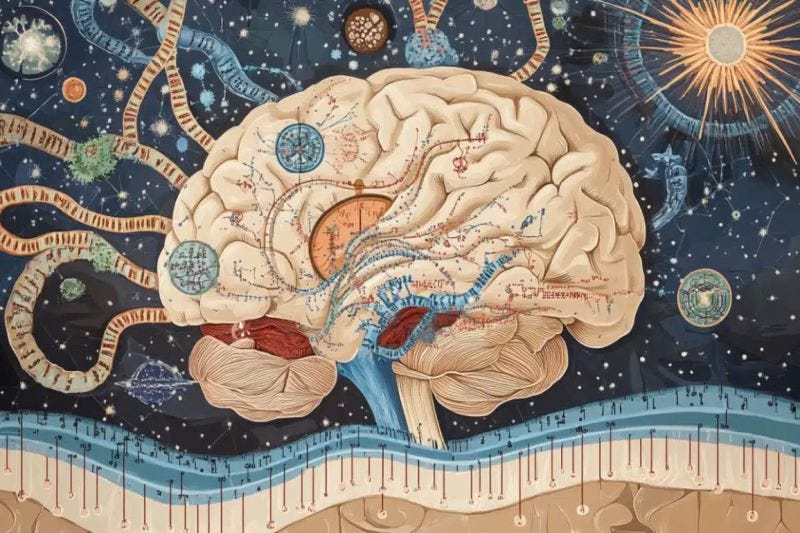AI Can Simulate Biology and Decode Mental Health
Expert takes from Omar Arias-Gaguancela PhD & Nicolas Hubacz MS
Decoding Biology Using Artificial Intelligence: Molecular Dynamics Simulations (MDS) and AI
Omar Arias-Gaguancela, PhD - Founder of SciLearningWorkshops and Author of Omar's Newsletter
Molecular dynamics simulations (MDS) are a powerful tool in structural biology, enabling researchers to model the behavior of proteins, whether in their apo form (without a ligand), bound to a ligand, or engaged in protein-protein interactions under various simulated conditions. These conditions include temperature, pressure, solvent effects, external fields, and solvation states, all within a computer-generated environment over time.
This type of in silico experimentation dates back to 1977, when Nobel laureate Martin Karplus performed a pioneering simulation of the bovine pancreatic trypsin inhibitor (BPTI) protein, lasting approximately 9.2 nanoseconds [1]. Since then, the field has seen substantial advancements. Thanks to improvements in specialized hardware and algorithmic design, modern MDS models can now simulate systems continuously for up to 1 millisecond and in aggregate, for slightly over 1 second.
Historically, MDS has relied heavily on physicochemical principles to inform the development of the algorithms that drive these simulations. However, recent integration of artificial intelligence (AI) has started to revolutionize the field. For example, tools like TorchMD use ML to learn and optimize force fields [2], while DeepMD replaces the classical force fields with neural network potentials trained on quantum mechanical data [3]. These approaches aim to model complex molecular systems at a significantly lower computational cost without compromising simulation accuracy.
Despite these advancements, many challenges remain. For example, AI-enhanced MDS experiments are currently being explored by a handful of research groups worldwide. More broadly, even the use of conventional MDS remains limited, primarily due to the high GPU computing costs that can be challenging for many laboratories.
Nevertheless, in the near future, it is anticipated that researchers will be able to input a protein structure and conduct multi-second, continuous MDS with various ligands, automatically identifying the best candidates for biological activity.
The potential applications of MDS in fields like drug development are especially promising. Compared to traditional in vitro testing, which is significantly more expensive and time-consuming when screening large libraries of drug candidates. In silico tools like MDS offer substantial savings in cost, time, and resources. This could greatly accelerate the development and release of biotechnological products for therapeutic use.
References
1. McCammon JA, Gelin BR, and Karplus M (1977) Dynamics of folded proteins. Nature 267, 585–590.
2. Doerr S, Majewski M, Pérez A, Krämer A, Clementi C, Noe F, Giorgino T, and De Fabritiis G (2021) TorchMD: A Deep Learning Framework for Molecular Simulations. J Chem Theory Comput 17, 2355–2363.
3. Zhang L, Han J, Wang H, Car R, and E W (2018) Deep Potential Molecular Dynamics: A Scalable Model with the Accuracy of Quantum Mechanics. Phys Rev Lett 120, 143001.
Decoding Mental Health Using Artificial Intelligence
Nicolas Hubacz - Business Development Manager at Magstim and Founder of NH Sponsorships
Neuropsychiatric diagnoses—like depression and autism—still rely heavily on subjective assessments. But a groundbreaking adaptive brain modeling framework may finally bring objectivity to the table.
📊 Researchers applied a refined Landau-Stuart oscillator model to over 1,300 fMRI scans from individuals with Major Depressive Disorder (MDD) and Autism Spectrum Disorder (ASD)—capturing nuanced, individual-level brain dynamics that traditional models miss.
Here’s what the model achieved:
🔍 Superior diagnostic accuracy vs. standard methods
🧩 Biomarker discovery in regions like the thalamus, precuneus, and insula
📈 Parameter correlations with clinical scores like HAMD (depression) and ADOS (autism)
Unlike prior one-size-fits-all models, this one adapts in real time, leveraging:
- Personalized gradient descent
- Dynamic learning rates
- A custom loss function that balances biological realism and statistical fit
🧠 This isn't just modeling—it's a precision neuroscience toolkit that bridges structure and function, enabling future personalized diagnosis, neuromodulation, and clinical monitoring.
The future of psychiatry may not start in a therapist’s office. It may start in the math.
A Big Thank You to Our Founding Member Subscribers: Dr. Joshua Nead| Peter Michiels| Thomas Malone | Darby Kramer





It's true AI can be a valuable tool also for supporting individuals with various communication styles, especially those who are neurodiverse or have ADHD. and in Other ways such as helping people talk in a way and express their feelings and stuff like that in a safe environment. I did it ok no my old blog if you want to check it out https://vocal.media/lifehack/empowered-expression-how-ai-can-help-neurodivergent-and-anxiously-wired-communicators-build-confidenceEmpowered Expression: How AI Can Help Neurodivergent and Anxiously Wired Communicators Build Confidence | Lifehack
Fascinating to see AI accelerating breakthroughs at both ends of the spectrum—from molecular simulations that may revolutionize drug discovery to brain models bringing objectivity to psychiatry. The future of medicine is being decoded—one algorithm at a time.